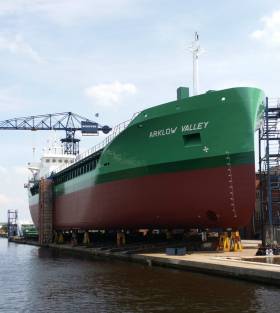Displaying items by tag: StaightStem energy bow
Another Eco-Trader Newbuild for Arklow Becomes Third Valley
#ThirdValley - Another addition to Arklow Shipping’s latest series of newbuilds built by Royal Bodewes, a Dutch yard in north-east Netherlands, was launched this morning, writes Jehan Ashmore.
Yard no.724, Arklow Valley, a 5,150dwat Bodewes Eco-Trader (yard's own design), is the fourth so far completed out of an order of 10 single-hold cargoships. Likewise of her predecessor, Arklow Valiant, she differs to previous pair of sisters, Arklow’s Vale and View (leadship launch video), in terms of the bow design.
The distinctive energy-saving straight-stem designed bow slices the waves coupled by an upper slope to deflect wave resistance. In this aspect, the Eco-Trader series of Arklow Valley/ Valiant, still displays the same typical lines up to the main deck, but the bow lines above this level no longer show the backward inclination of Vale/View, but rather continue going straight up to the top.
The new design also provides an improved vision to the bow anchors while anchoring.
Arklow Valley was given the customary broadsides launch into the canal at Hoogezand and under clear blue skies.The yard near Gronignen, was not open to public for the launch, however they were welcomed to watch from the far side of the canal embankment as the 2,999 gross tonnage newbuild entered with a splash!
When the 86m Arklow Valley is delivered, she will be the 10th newbuild since 2014 for Dutch division, Arklow Shipping Nederland B.V.
This is the third ‘Valley’ cargoship of the ‘V’ class nomenclature series in the 50th year of Arklow Shipping. One has to go back to the early 1990’s when a ‘Valley’ has been on the fleetlist, this namesake was a 2,827gt low-air draft cargoship that featured a telescopic bridge. This design enabled the German (Weselsfleth) built vessel to pass under bridges on waterways to reach inland ports.
As for the original ‘Valley’, this was the Dutch 1977 (Foxhol-launched/Schiedam completed) cargoship, which was lengthened in 1980. Four years later, the 1,707gt cargoship became part of the Arklow fold, with outright ownership by ASL in 1987.
The Co. Wicklow company, headquartered on the banks of the River Avoca, Arklow, easily has the commanding position of Ireland’s largest privately owned merchant fleet of 30 ships. This excludes the Dutch division, in which Arklow Valley becomes their 18th Dutch-flagged vessel.
In total the combined fleets number 48 ships and appropriately, the Irish flagged cargohips are registered at their respective homeport of Arklow.
The ‘V’ class leadship, Arklow Valiant, launched in April also by Bodewes, arrived from Waterford to dock in Dublin Port this week where she remains berthed at Ocean Pier. Among the typical cargoes loaded at this berth is peat-moss.





























































